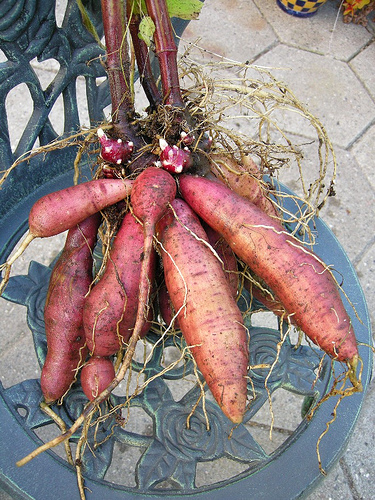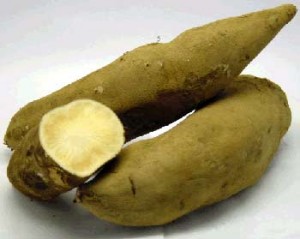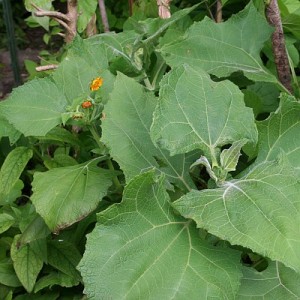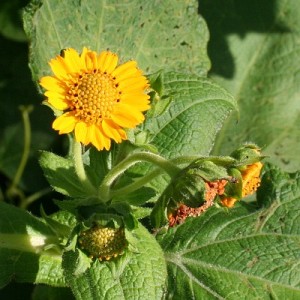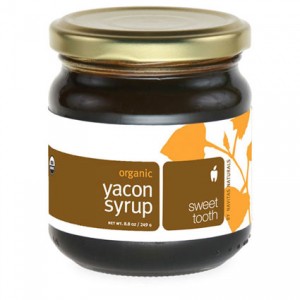Is it a Polymnia or a Smallanthus? Botanists took some 70 years to make up their minds. Let’s call it Yacon like the natives.
In publications before 2000, particularly the Journal for Economic Botany in 1991 and Cornucopia II 1998, it’s Polymnia sonchifolia, poh-LIM-nee-uh son-khi-FOH-ll-uh. Polymnia is Latin for the Greek goddess of sacred poetry, hymns, eloquence, agriculture, pantomime and sometimes geometry and meditation. She was often shown with a pensive finger touching her mouth as in thought. That really helps us in identifying the species.
Smallanthus (small-ANN-thus) in use more on the Internet and after 2000 and in recent professional journals. The genus name was first proposed in 1933, advocated in 1978, and as the botanists say “currently preferred” some 79 years later. It means “small flower” which is certainly more descriptive than a “pensive goddess.” The flowers aren’t really that small but the plant grows rather large so they look smaller than they are. When the genus was switched from PolymniA to SmallanthUS the species name had to follow Dead Latin endings and went from sonchifolia to sonchifolius. That reminds me of a scene from the movie Life of Brian in which the Centurion does not arrest Brian for writing anti-Roman graffiti until Brian corrects the Latin endings.
Whether a Polymnia or a Smallanthus sonchifolius make more sense. It means like a sow thistle. In practical terms that usually translates into meaning the leaf has no stem and attaches directly to the main stem of the plant, often nearly wrapping around it. Emilia sonchifolia, another edible, was so named for the same reason. An older name for Yacon, Polymnia edulis (Edible Goddess) is sometimes still seen.
Yacon (yah-KON) also Llacon, Strawberry Jicama, Bolivian Sunroot, Ground Pear, and Apple of the Earth, grows wild in areas of South America. They can be eaten raw, cooked or pickled. The flavor is between an apple and a pear. Very tolerant of sun and drought they are often “cured” for a week or two before eating, as one does with sweet potatoes. You can, however, eat them immediately out of the ground. “Curing” activates an enzyme process which increases sweetness significantly. Specifically prebiotic oligofructans (indigestible sugars) are converted into fructose, glucose, and sucrose. This would mean right out of the ground they would feed your gut bacteria. Once cured the roots has more available sugars.
At the end of the plant’s reproductive cycle the top starts to wither. From that point on the root is increasing in sweetness. Said another way when fresh out of the ground the roots are at near-optimum stage for diabetic consumption, the non-digestible sugars are high and the roots is not overly sweet. As it sits for several days, particularly in the sun, enzymes change the non-digestible sugars into digestible ones such as fructose and sucrose. While this increases the sweetness it also increase the kinds of sugars diabetics should avoid. Thus if you are making diabetic sugar or syrup out of the roots they should be processed immediately. If you are a diabetic raising them they should be eaten sooner than later. In a related issue the probiotic strains Lactobacillus acidophilus, Lactobacillus plantarum, and Bifidobacterium bifidumare able to ferment Yacon root in the gut.
About the only drawback to the plant is it needs about 200 frost-free days to complete its annual cycle thus it has been imported to other warm areas of the world. In areas with shorter growing seasons they can be started inside indoors. A common grocery store item in New Zealand it has also been actively cultivated in Japan, Korea, Taiwan, the Czech Republic, Germany, French, Russian, Estonia, the United States, China, where it is called Snow Lotus Root, and Italy where it is used to make alcohol and inulin. Depending upon the variety the roots can be white, crystal white, violet, orange or yellow. The white fleshed ones are not as sweet as the others.
Green Deane’s “Itemized” Plant Profile: Yacon.
IDENTIFICATION: Smallanthus sonchifolus: Under right conditions the plant can grow to some seven feet tall producing two kinds of roots, small ones near the surface (the little red caudices in the top picture) which are used to propagate more plants and larger storage roots below, used for food. The main stem is covered with dark green leaves and violet-colored hairs. Blossoms are about 1.25 inches (30mm) in diameter, yellow or orange, growing on top fo the main stem and on other stems from lower nod buds. Flowers are limited as the plant reproduces via caudices. Fruit is black, 2mm achenes. It looks similar to a relative, Jerusalem Artichoke.
TIME OF YEAR: Where frost free they can grow or and be grown year round. Roots are available when the flower top withers.
ENVIRONMENT: Likes sun and water and good, drained soil. Fertilize like a potato or you will get a lot of leaves and small roots. When raised properly roots average about 10 ounces each. Can be much larger.
METHOD OF PREPERATION: Peel the root before eating raw. Eaten out of hand, or sliced and added to salads to add sweetness. Curing the roots in the sun increases sweetness but reduces crispness. Grated pulp from fresh roots can be squeezed in cloth to produce a refreshing drink, juice can be reduced to sugar or syrup. The root can be boiled, baked, fried, pickled. Young leaves and stems can be boiled and eaten as a green. Not all that good. More often leaves are used to make a tea that is good for diabetics to reduce oxidative stress and control blood glucose levels. The foliage is good forage for livestock.
Yacon seed stock can be ordered from B&T Seed.

